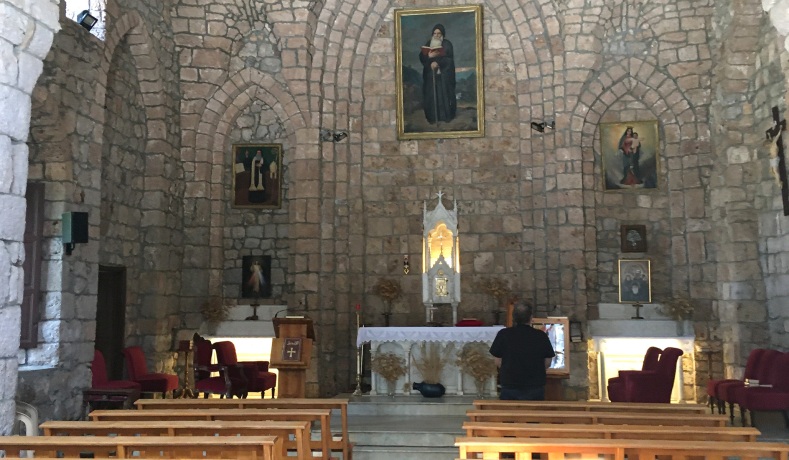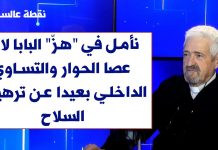Into Mount Lebanon/في جبل لبنان
Andrew Doran/National Review/March 04/2022
Picture Enclosed/The chapel at the Monastery of Saint Anthony Abbot, Wata Houb, Lebanon
Even after two hours of driving up Mount Lebanon, a range that spans over a hundred miles along the Levantine coast, you never quite feel that you’ve arrived; there are, somehow, always more mountains. With the Mediterranean at our backs, a Lebanese friend and I travel eastward and upward, by twisting roads that intersect with pathways ancient and new — even the Via Appia, from which all roads led and by which they returned to Rome. We drive to meet a monk.
Seventeen centuries earlier Abraham, a monk, made this same ascent on foot at the behest of Saint Maron (for whom the Maronites are named), to convert the recalcitrant and sometimes violent Phoenician pagans of Mount Lebanon. The mountain was sacred to the Phoenicians, and there they clung to ancient rites to appease terrifying deities. Brother Abraham succeeded in his mission, despite much hardship. The caves that for millennia were the scenes of macabre sacrifices by torchlight became the site of a new ritual, one that reenacted a single blood sacrifice in Jerusalem three centuries before.
God offered himself in place of men, Abraham taught them, and that sacrifice was sufficient. And so the stubborn pagans of the mountain became stubborn Christians; the River Adonis became the River Abraham, or Nahr Ibrahim. Into the holy valleys of the mountain went the followers of Maron, and there they chiseled monasteries and catacombs into Mount Lebanon. The people followed them and built homes and villages to be near these spiritual centers. On every windswept peak and precipice they erected a crucifix or statue of Mary that could be seen for miles. There they survived conquest and persecution by Persians, Turks, Mamelukes, and other invaders, who in every century seem to occupy the low-lying coastal city-states below — but never Mount Lebanon.
It was toward the mountain’s heights that we drove, and the further we went, the more the gravity of the crisis below — economic and political collapse, sudden poverty, the perpetual threat of war — seemed to lighten with the air, a momentary respite from the burdens of a world that felt especially heavy. The monks here as elsewhere aren’t entirely liberated from the human condition, but neither are they quite shackled to matter and time. Two weeks earlier I visited the Capuchin friary in Rome, where mosaics and altars made of the bones of deceased friars serve as a memento mori, with an inscription for pilgrims: “What you are now we used to be; what we are now you will be.” Similarly, the Maronite monks asked that their bones be kept on the altar as a reminder to all that this life is only preparation for the next.
The Maronite monk whom we went to meet was my friend’s cousin, named for a saint from Mount Lebanon revered by Muslims and Christians alike but whom we’ll call, at his request, “Brother Thomas,” for his privacy and his reverence for the angelic doctor. “He is a saint,” a woman who’s known Brother Thomas all his life told me before we left. “You will see.”
We arrive at the Monastery of Saint Anthony Abbot, named for the Egyptian monk who was the founder of all Christian monasticism — an institution that, like Christianity, is Middle Eastern in origin. Like the Jews of Qumran, early Christian monks and hermits broke away from a world they believed to be too pagan — the Jews in rejection of the secular Hellenized world, the monks in preparation for the end of their lives or the end of the world. It was just such an extreme break with the world that brought Brother Thomas to a monastery on Mount Lebanon.
Brother Thomas, slender and energetic, graciously greets his cousin and me, and after a brief tour we sit together in the monastery’s courtyard. Brother Thomas has considered opinions on theology, science, dating, chastity, unchastity, engineering, sanctity, geology, Christian civilization, monasticism, Judaism, and the decline of the West, and he wastes little time expressing them. “Do you know that Benedictine monasticism saved Western civilization?” he asks. Some of his views are too strident for his cousin, some years older, who smiles and says, “You see? He’s our version of the Taliban.” They laugh.
It’s about 40 years since Brother Thomas was born into a Lebanese family with vast generational wealth, and 15 years since he oversaw every detail of a $300 million waste-to-energy recycling project in America. It was there, rather than the Middle East, that he had a conversion. In the corporate world, he was known to work 20-hour days and sometimes sleep in his office. “My darkness was that of the heathen person,” he says. “Thomas Aquinas teaches that desolation is the emptiness of God. God allows desolation as a punishment so that the person might be redeemed. Then you will be given happiness as a reward.”
Monasteries used to be ubiquitous in Europe and the Near East. Most people in those regions lived within walking distance of a monastery for most of the past 2,000 years. This is in stark contrast with America, a predominantly Anglo-Protestant culture, where the closest approximation to monasticism are the Amish and Mennonite communities, and where monasteries are rare. Yet it was in heavily Anglo-Protestant America that Brother Thomas’s journey to this monastery on Mount Lebanon began. It was at a church in rural Pennsylvania that he contemplated an interior desolation. “It’s still a blessed place for me,” he says of the church. “When you have a conversion, you don’t forget it.”
“I had everything,” says Brother Thomas. “I came from a rich family. And yet I was horribly depressed. You think you’ll get fulfillment from money or work but you can’t. In truth, I was dying.” He decided that he must begin to live the Christian life, and that he must do so radically.
Five years later, he began to experience what he calls intuitions. The intuition he heard asked, “Why don’t you become a monk?” This wasn’t easy for his family, including his cousin, who was grooming Brother Thomas for corporate leadership. “He was the perfect engineer,” his cousin says. “The perfect executive. A great businessman. He was a legend [at the corporate offices] in America. The employees still ask after him, even the security guards.”
His cousin tried at first to discourage Brother Thomas from entering the monastery, thinking he could do more good in the world in business, society, and culture, but eventually relented. “You cannot stand against the will of God,” he says. He may also have suspected that the stubborn soon-to-be monk would in any case follow the intuition that led him to the monastic life and that to discourage him would be pointless.
More than once, Brother Thomas recalls words of the French novelist Léon Bloy: “The only real sadness, the only real failure, the only great tragedy in life, is not to become a saint.”
In three gospel accounts, Jesus was approached by a young man who asked what he must do to have salvation. Jesus told him to sell his possessions, give to the poor, and then “come, follow me.” The young man departed in sadness, “because he was very wealthy.” Brother Thomas was also very wealthy, though, unlike the young man in scripture, he did not always follow the commandments. Also unlike the young man, however, Brother Thomas gave away his earthly wealth and followed Jesus. It was a radical break — from wealth, a career, the world, and even his family.
Brother Thomas’s conversion began with a sense of spiritual emptiness, followed by intuitions that drew him to the monastic life. “The Christian life is radical. The call to sanctity is universal but also radical. If you want to live a radical life, it’s hard to live among those who aren’t radical. God commands us to love. Saint Thomas teaches that love is governed by one law: perfection. Tell me how love can be moderate. How can love be anything but radical? Love and radicalism — perfection — are inseparable.”
His decision to enter the monastery was hardest on his parents, especially his father, who struggled to understand his son’s zeal, a familiar theme in Christian history. We can imagine that the family of Benedict of Nursia wasn’t thrilled when, “forsaking his father’s house and wealth,” he withdrew into a life of monasticism. Thomas Aquinas’s family, Italian nobility, tried to prevent him from entering the Dominican order by imprisoning him for a year; they even tried to lure him from his vocation by sending a prostitute. Francis of Assisi was born a generation before Aquinas to a wealthy family, and his vocation similarly enraged his father, who thought he’d gone mad. Each man’s assent to a radical life had profound consequences for history.
The rich young man of the gospel is remembered only for his decision to cling to the possessions of this world. He apparently wished to compartmentalize the worlds of matter and spirit. He no doubt knew of the Essene Jews who had withdrawn from a world they believed too pagan, too worldly. He likely regarded them as extreme and hoped to find a way to live in the world. Brother Thomas believes that to be impossible, and he believes that the model for the radical Christian life has its origins in the first branch of Abraham’s family.
“Look at Judaism,” he says. “Faith penetrates every aspect of their lives. It’s the opposite of laïcité. Nothing can be hidden from God. We sprang from the Jews and our closeness to them is very important for Christians.” It’s a somewhat unexpected disquisition for the Middle East, though perhaps fitting after a brief sojourn through a river valley named for Abraham.
Two thousand years later, many descendants of Abraham live in enmity. This monastery feels far removed from the failing state below, much of it hostage to a terrorist organization and its ideology rooted in antisemitism. This monk has staked out curious terrain and defends it without fear. “You know, anyone who looks at Judaism with denigration does so because of improper formation. The church teaches that the Old Covenant was never abrogated. Saint Paul says the same. Christians come from the Jews, and we must learn from the Jews again. Faith must penetrate everything, every part of our lives and our culture.” So it was for the Jews who withdrew from the world into the proto-monastic communities of the Judean Desert, and later for the Christian monks of Egypt and the Levant and Europe.
How could monks withdraw from the world, have no families or children, yet leave a legacy that lasted centuries? How could a person from wealth or nobility give it all away, retreat from the world, yet change the course of history? The rich young man simply couldn’t see it. Perhaps even Benedict of Nursia couldn’t imagine that his retreat to the hills outside Rome would lead to the reconstruction of the world that was dying before his eyes. The Western Roman Empire collapsed, and with it the state and its institutions, as wave after wave of barbarians descended on Italy from every corner of the earth. Benedict’s retreat from the world was radical.
Brother Thomas regards the church and its traditions as the protector of civilization, but his own calling was not grandiose; indeed, he has yet to decide whether he feels called to the priesthood or will remain merely a brother in his order. The calculus for him, however, was and remains quite simple: “If a Christian man hasn’t made the decision to give his life to Christ, I think he’s not very intelligent. It’s like a business manager who doesn’t check profits and losses. Such people are lost. They must not understand what life is about.”
Families aren’t the only ones who lament when young men break from the world and enter the monastic life. In his Decline and Fall of the Roman Empire, Edward Gibbon likened the spread of Saint Anthony’s monasticism throughout Europe to a plague. Gibbon, who favored pagan virtù to Christian piety, seems to have held monks in the same contempt that he had for the scheming “eunuchs and women” of the imperial court.
Roman men who for centuries joined the legions and fought off the barbarians were followed by generations of men who entered the monastic communities of the pacifist religion that spread like brush fire from the Near East across the Mediterranean to the northern boundaries of the Roman Empire and beyond. Wave after wave of barbarian invaders came at the empire and eventually overwhelmed it. Even as they came by every road toward Rome, missionaries and monks set out by foot into barbarous country to convert the pagans. The monasteries and religious communities were conquered, destroyed, and rebuilt. Monte Cassino abbey in Italy has been destroyed by Lombards, Napoleon, Nazis, and earthquakes — and every time rebuilt.
The barbarians are, as in the age of Benedict and Augustine, never far off, bent on plunder and destruction. In Lebanon, their work was visible in the wreckage from the August 2020 Beirut Port blast, in the littered streets, in the despairing eyes of a people brought to ruin by their venal elites, who sold their futures in exchange for fleeting power or wealth. Less visible was the spirit that endures the rise and fall of states and empires, that called the monks and religious of history away from the world so that the world might be converted. John Henry Newman captured it well in his reflection on early medieval monasticism, words that may be instructive beyond Lebanon. Saint Benedict, he wrote,
found the world, physical and social, in ruins, and his mission was to restore it in the way not of science, but of nature, not as if setting about to do it, not professing to do it by any set time, . . . but so quietly, patiently, gradually, that often till the work was done, it was not known to be doing. . . . Silent men were observed about the country, or discovered in the forest, digging, clearing, and building; and other silent men, not seen, were sitting in the cold cloister, . . . while they painfully copied and recopied the manuscripts which they had saved. There was no one who contended or cried out, or drew attention to what was going on, but by degrees the woody swamp became a hermitage, a religious house, a farm, an abbey, a village, a seminary, a school of learning, and a city.
This is how civilization survives decline and barbarism. “The history of mankind is the history of the devil trying to destroy God’s people,” Brother Thomas says. “The Jews in bondage and exile, and then the Holocaust. The waves of pagan barbarians, heresies, communism, and all the false gods. If you follow God, the devil will try to destroy you.”
He believes that it is normally the few, rather than the many, who alter the course of history. “True Christians are a small — very small — minority,” he says. “Saints are few. It’s always been this way, I think.” Saints also tend to be intense, eccentric, and maddening to their contemporaries. Relatives often regard them as disappointments or madmen.
Like Benedict, Brother Thomas watched the world he knew collapse, but he chose to fix his gaze on the eternal rather than the world. As our visit drew to a close, there was the haunting reminder that it often seemed impossible to be a Christian in the West yet felt nearly effortless here. It was like hearing an echo of the call that the young man heard before he turned away in doubt. Such doubts are not new and are, Brother Thomas believes, perfectly human. Indeed, the struggle against doubt is part of the spiritual journey. “The freedom that God gives us is unlimited: Even after a mystical experience, we can still say, as the once prince of Angels said, ‘Non serviam.’ I guess our fight with incredulity will last until our very last breath.”
It was a consolation to think of the cacophony below as the passing distraction, to think that the real work was to be done here, that civilization would be saved by the “silent men” who in every age of upheaval transmit old learning, build schools and hospitals, and gather in hills and mountains as the world below comes apart. Those silent men are still in the deserts of Egypt, in the hills outside Rome, and on Mount Lebanon.
We left Brother Thomas and the monks and departed by the winding mountain road back to the world of space and time, to the blend of civilization and barbarism that awaited us below. As we rounded a bend, my friend slowed the car and we looked back across the steep gorge that now separated us from the monastery, burrowed into the mountain, the mountain that had waited patiently for the arrival of Maron and Abraham. Perhaps it waited now for another — doubtless very similar and equally radical — Anthony or Benedict or Thomas.
https://www.nationalreview.com/magazine/2022/03/21/into-mount-lebanon/?fbclid=IwAR0FXajPz-eG8oTQD5u2SQTRFBSgSrGAgORYAAODaWyjW9cBFPCxGiIcj5w






















